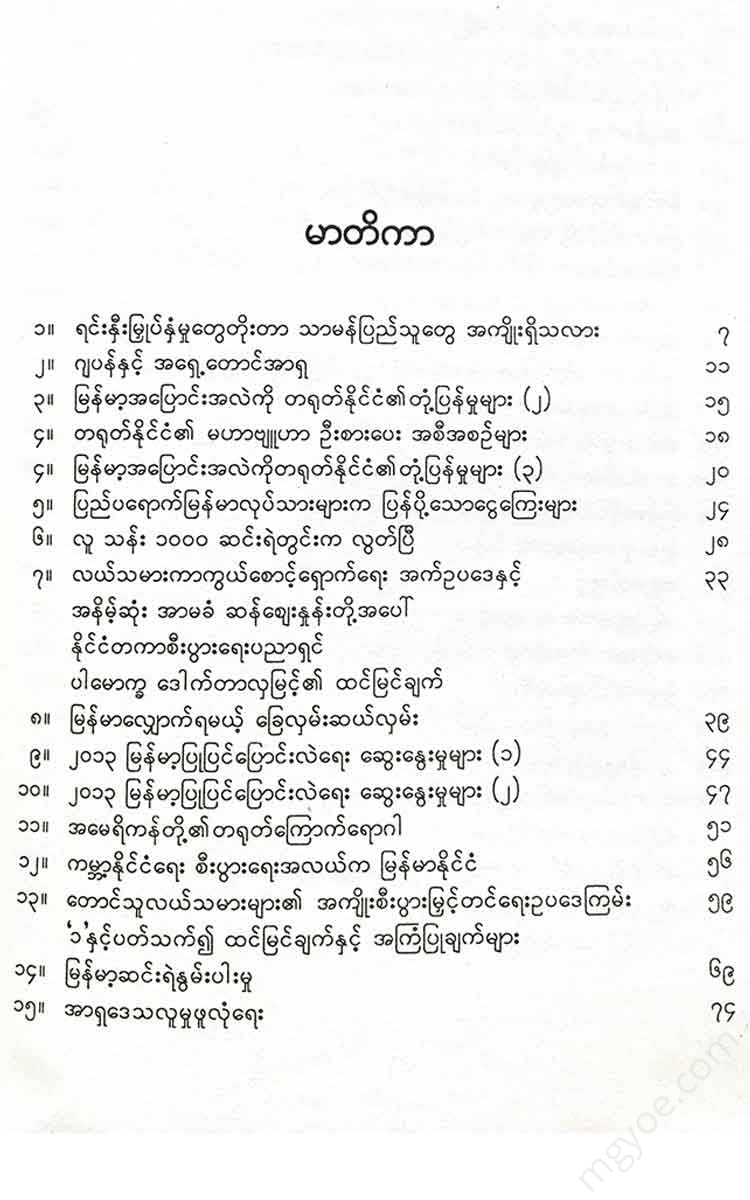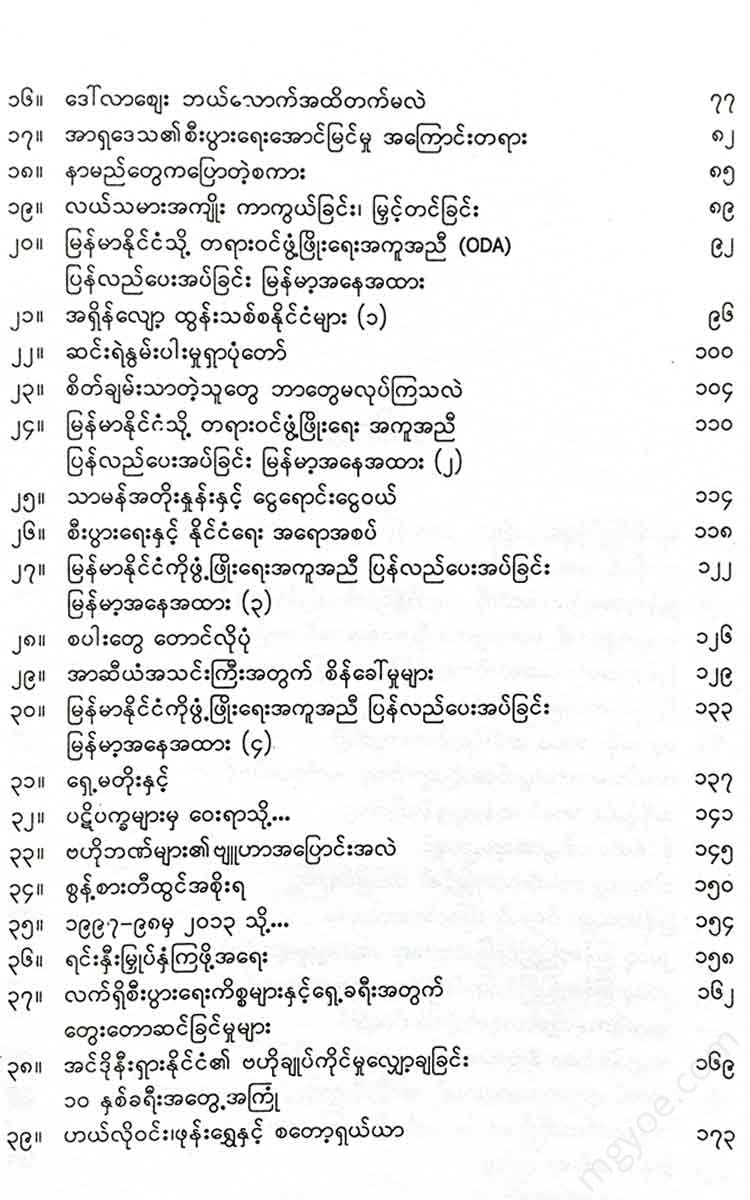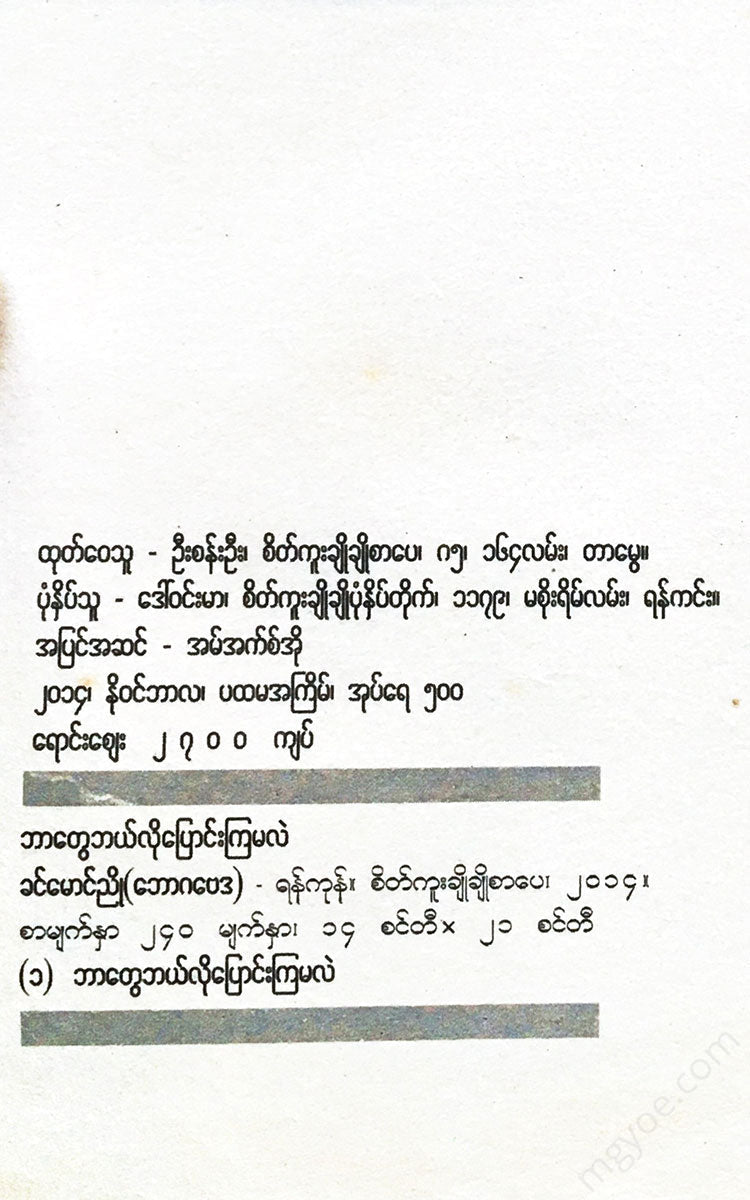စိတ်ကူးချိုချိုစာပေ
Khin Maung Nyo (Economics) - What will change and how?
Khin Maung Nyo (Economics) - What will change and how?
Couldn't load pickup availability
Does increased investment benefit ordinary people?
China opened its doors about 30 years ago, and Myanmar's reintegration into the global economic community after 1987 is one of the most promising developments in Asia.
Myanmar has a market of 60 million people who are still untapped, and it is strategically located between China, India and Southeast Asia, which are rich in natural resources. It is therefore not surprising that it is being called a new frontier. Not a week goes by without a new landmark being set.
Recently, a Japanese prime minister visited for the first time in 36 years. Last year, the current US president visited.
Ford will open its first new car showroom in Myanmar in decades. Coca-Cola will soon open its first bottling plant in nearly fifty years. Myanmar's first ATM has been put into service. The head of Google also visited.
All the world’s top brands and companies are lining up to enter Myanmar. Behind them, smaller companies are sending executives to see if they can get something before the opportunity runs out. The US has lifted many economic sanctions. President Thein Sein signed a new trade agreement during a recent visit to Washington.
The European Union has also lifted economic sanctions on all exports except arms and is considering granting Myanmar companies preferential access to the European market under the Generalized System of Preferences (GSP). Everything seems to be going smoothly.
But we shouldn't blame Burmese for wanting to know if they're still benefiting. Citizens of one of the poorest countries in Southeast Asia certainly need to improve their living standards.
“The problem is that there is a lot of interest, but the real money, the real investment, is not coming in. They are assessing the situation. And they are realizing that there are difficulties and obstacles. So, the money is not really coming into the country,” said the Asian Development Bank’s deputy chief economist.
Foreign investment is said to have increased fivefold last year, but it has only increased from $300 million in 2011.
Myanmar's needs are much greater. It needs millions of new jobs for its very poor, mostly rural population. It also needs significant investment in infrastructure.
One of the difficulties with Myanmar is the lack of legal certainty and clarity.
The new foreign investment law was debated for months before it was enacted last year. It also took time for it to be officially translated. Even now, there are still some misunderstandings about its meaning.
There are also some drawbacks. For example, many projects that require local businesses to be used do not have local businesses. “The law is not perfect. It will have to be improved gradually. We can’t wait,” said U Set Aung, deputy minister of the Ministry of National Planning and Development. “We need to create a conducive investment environment. Now we have the concept of a special economic zone and we need to put in place short-term policies in terms of tariffs and utilities,” he added.
The government has planned a number of special economic zones. The most promising is the Thilawa Special Economic Zone, a 4,950-acre (2,001 ha) area outside Yangon. The zone, funded by a number of Japanese companies, is due to start construction this year.
Special economic zones are essential to attract job-rich investments such as the garment industry. Currently, the country lacks the infrastructure to support these types of garment factories.
Unreliable electricity is also a huge problem. 70% of electricity comes from hydroelectric power, so electricity production decreases during the dry season. The use of generators increases costs and reduces the competitiveness of low-profit garment industries.
The main port in Yangon is also underdeveloped, adding to the cost. Few container ships can enter, and shipping rates fluctuate wildly. A garment factory owner said that it is cheaper to ship from Bangkok than from Yangon, after 24 hours of crossing the border by road.
The deputy minister said the government is negotiating with foreign investors to build new power plants and work to increase the power generation capacity as soon as possible. Japanese and Thai companies are interested, but the projects will take years to complete. Small investors are also finding it difficult to overcome the challenges they face in setting up businesses in this new frontier. A representative of the Thai-Myanmar Chamber of Commerce said that while large companies such as CP PTT and telecommunications companies are planning to invest significantly, small and medium-sized enterprises are hesitant due to rising land prices, ownership uncertainty and lack of clear legal protection in court.
However, Myanmar's needs, resources, and consumers will continue to attract investors.
“After democracy and economic reforms, the huge consumer market will continue to grow in the long term,” said Massril Takahara of the Japan External Trade Organization (JETRO) . So far, there are few competitors from the United States and Europe. So Japanese investors are interested in gaining a foothold in the market before others enter, in sectors such as construction, warehousing and transportation, household appliances, retail, motorcycles and advertising. There are also quick-return investments that can quickly improve the lives of ordinary people, such as spending on tourism and investing in rural areas where most people live, he added.
However, he added that improving infrastructure is important. “To establish a tourism industry, the foreign investment law needs to be clear about transportation, land use, how to attract tourists, and where to go in Myanmar. With four seasons in a year, we can grow a variety of fruits and vegetables. But because they are perishable, we need to get them to customers quickly and efficiently. For this, we need roads, railways, ports, and infrastructure.”
Japan and Southeast Asia
On May 26, President Thein Sein welcomed Japanese Prime Minister Shinzo Abe to the Myanmar capital, Yangon, and they exchanged diplomatic signals of mutual respect. Mr. Abe is the first Japanese prime minister to visit Myanmar since 1997. Both leaders appear determined to strengthen diplomatic and economic ties that have been good for years, even during decades when the West shunned the military junta. Mr. Abe, who also met with Burmese opposition leader Aung San Suu Kyi, pledged to provide all possible assistance to the country’s new reforms that President Thein Sein has been trying to implement since 2011.
Japan’s actions are also consistent with its words. Mr. Abe has promised to write off $1.8 billion in Myanmar’s outstanding debt and lend another $500 million. This is in addition to the commitment Japan made 18 months ago to help with the Thilawa Special Economic Zone, south of Yangon. Japan has already spent $200 million on the Thilawa Industrial Zone. The old port will be replaced by a new one. Mr. Abe was accompanied by dozens of Japanese officials, who urged them to seek opportunities.
Myanmar is the most fashionable and attractive investment destination in the region. But other countries in Southeast Asia have already benefited from Japanese investment. Since Mr. Abe took office in December, his ministers have been visiting Southeast Asian capitals to offer new investments, aid and other incentives. He wants to boost his economy by taking a bigger place in the 10-nation bloc of ASEAN, which has few economic prospects. But the ministers are not just talking about trade. They are also discussing diplomatic alliances, naval training and defense sales. The push into Southeast Asia is also due to strained relations with China. A standoff with China over Japan’s control of the Senkaku or Diaoyu islands in the East China Sea has exacerbated the differences between the two countries. Anti-Japanese sentiment in China has Japanese businesspeople worried about the long-term future of Japanese investment in China. A Reuters survey of Japanese businesspeople last year found that about a quarter of respondents said they would postpone or scale back investment plans in China. Southeast Asia is increasingly seen as a place of diplomatic and economic containment of China.
As part of its regional financial integration program, Japan is investing in government bonds in ASEAN member countries. The Japanese Ministry of Finance has helped Japanese businesses borrow in local currency. Some large companies have consolidated their operations and control entire supply chains in Southeast Asia, often centered in Thailand. For example, Honda Motor Co. aims to produce 424,000 cars a year by 2015. To achieve this, Japanese companies need local capital. After severe flooding in Thailand in 2011, the car factory and other Japanese factories were closed, but there was no fundamental change in business plans. Insurance companies have stepped in to cushion the losses.
In Indonesia, where Japan has long had a close economic relationship, Japan recently won a $370 million contract to start building a new subway in Jakarta. The city, which is flooded and built on mud, is a challenge that Japanese engineers enjoy. But Japan has also been unusually active in other Southeast Asian countries with which it has traditionally had little contact. In particular, it has befriended Vietnam and the Philippines, both of which are at odds with China over islands and reefs in the South China Sea.













